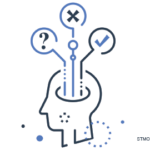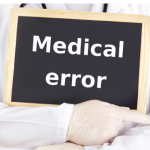
Audio und werbung / shutterstock.com
On Dec. 27, 2017, RaDonda Vaught killed Charlene Murphey, allegedly.
Ms. Murphey was a lifelong resident of Gallatin, a suburb of Nashville, Tenn. She was well known from having worked at the local Walmart for 24 years, before she retired in 2012, when she was 65 years old.1
On Dec. 24, 2017, she was helping prepare Christmas dinner when she developed a headache and lost vision in one eye. She was taken to the Sumner Regional Medical Center, where she was discovered to have a subdural hematoma; she was subsequently transferred to the neurologic intensive care unit at Vanderbilt University Medical Center, Nashville, for closer monitoring.2
Two days later, she started to recover, and plans were made to send her home. Her physicians suspected she might have an underlying malignancy, however, and ordered a positron emission tomography (PET) scan.
There was a problem. The patient had claustrophobia and was unable to sit still through the procedure. Her nurse asked a colleague, Ms. Vaught, if she could take a milligram of midazolam to the patient, so the PET scan could be completed.
Ms. Vaught was busy. She was orienting a new nurse to the floor and had already been assigned a new patient, who was waiting to be admitted from the emergency department. She didn’t know how to find the radiology department, and she wasn’t familiar with midazolam, having administered it only a few times. But she was willing to help a colleague. So, trainee in tow, she went to the automated medication dispensing system to obtain the drug.
This might be a good point to pause and allow you to get some Monday morning quarterbacking out of your system. Why didn’t Ms. Vaught just say no? She was already preoccupied with her own work, without having to worry about how to find the PET scanner and administer a drug she knew nothing about. Why didn’t she ask more questions about midazolam? She later admitted that she didn’t know that midazolam could be sedating, and an elderly patient might require additional monitoring after administration. Why was the patient ordered to receive midazolam? Patients’ recovery from neurologic events is generally tracked by assessing their mental state; administering a drug that could suppress her level of consciousness seems counterintuitive. And come to think of it, why did she need the PET scan when she was admitted to an intensive care unit? As hospitalists are fond of saying, this sounds like an outpatient procedure, one that might have been more appropriate after she had some time to rest and recover from recent events. If any of these questions had been asked at the time, the story might have ended here.
We may never know the answers to these questions, but we could certainly take a few good guesses. First, healthcare providers are trained to never say no. Lack of experience, expertise or sleep are generally not viewed as valid excuses. Second, electronic drug references are designed to be complete, not digestible, and certainly not something that could be reviewed on a smartphone while you’re trying to figure out where radiology is located. As for the PET scan, it is often easier to have expensive procedures approved while a patient is admitted to a hospital; I’m sure the neurointensivist thought he was being helpful.
Most importantly—none of us was there. These decisions aren’t straightforward, and second-guessing the decisions of another provider is a dangerous sport. Whatever the explanations, I’m sure they made sense at the time, and I wouldn’t be quick to assume that we would have acted differently.
At this point in the story, Ms. Vaught is trying to persuade the automated medication cabinet to give her the drug she needs, so she can resume the rest of her busy day. She had already confirmed the patient had been ordered to receive midazolam, but the medication cabinet could not be convinced. This wasn’t unexpected. The hospital had recently transitioned from McKesson to Epic for order entry, and the new order system was still having problems communicating with the extant pharmacy system.3 The nurses were instructed to use electronic overrides to force the electronic cabinets to comply.
Following the override, she tried again and was finally successful. She opened the vial, reconstituted the drug and went with the new nurse to find the radiology department.
She walked away with vecuronium.
Had Ms. Vaught typed midazolam into the medication cabinet, the story might have ended here. Unfortunately, she had used the drug’s more common trade name, Versed. And when she typed in the first few letters of the drug, the automated cabinet dutifully spit out vecuronium, a paralytic agent used to facilitate intubation.
The investigator for the Tennessee Board of Nursing noted that Ms. Vaught would have had to ignore a number of red flags to get to this point.4 First, midazolam is a solution, while vecuronium is a lyophilized powder. Second, the vial has a red cap, designed to alert the user that it is a dangerous drug. Third, a warning on the label indicates vecuronium is a paralytic agent.
Truthfully, I’m not sure any of those red flags would have saved me. I had no idea that midazolam isn’t packaged in a powder. A red cap on a vial wouldn’t have looked particularly foreboding to me. As for the warning, it appears in red—the same color used to indicate the final concentration and the milligrams of drug in the vial—in a font so small only a lawyer could read it.5
At this point in the story, Ms. Vaught is at Ms. Murphey’s bedside, administering the paralytic agent. Ms. Murphey subsequently suffers a myocardial infarction and anoxic brain injury that led to a complete loss of brain function. Her family removes her from life support on Dec. 27, 2017, four days after she was cooking Christmas dinner.6
First, Do No Harm
Medical error is not the third leading cause of death in the U.S.
In 2000, the Institute of Medicine published an oft-cited, rarely read report titled To Err Is Human: Building a Safer Health System.7 This report extrapolated the results of just two studies to estimate that at least 44,000 Americans die each year as the result of medical error, making it the eighth-leading cause of death in the U.S. In 2016, Michael Daniel and Martin A. Makary from the Department of Surgery at Johns Hopkins University, Baltimore, updated this analysis. They examined the results of studies conducted since the Institute of Medicine report and estimated the death rate due to medical error in the U.S. had increased to 250,000 per year, making it the third-leading cause of mortality in the U.S.8
This is implausible. If this analysis were correct, then preventable medical errors would be responsible for 62% of all hospital deaths, which strains credulity.9 Where did Daniel and Makary go wrong? First, they didn’t take into account the populations studied by the papers they cited, so they extrapolated overall hospital mortality using studies that focused on pregnant women, the elderly or other specific populations that don’t represent the universe of hospitalized patients. Second, they assumed that all medical errors were causal. In other words, if a hospitalized patient were given an extra dose of aspirin and subsequently died of congestive heart failure, they assumed the aspirin caused the patient’s death.10
A subsequent meta-analysis of 70 studies, which included 337,025 patients, estimated that only 0.7% of hospital deaths are due to preventable medical error, about half of which are attributable to drugs or an intervention.11 But because that observation isn’t as catchy, the third-leading-cause meme lives on in the popular press.
Why do medical errors occur? One reason, of course, is cognitive error. Jillian Horton, MD, who was the associate chair of the Department of Internal Medicine at the University of Manitoba, eloquently states the other reasons:12
There are other reasons we make errors. Inexperience, when we’re young. Fatigue. A system that constantly asks us to play the odds that most people won’t die if we only skim the surface of their history. Pressure to look after more and more patients whose problems are increasingly complex. New and cumbersome electronic systems dumped on us with increasing frequency and too little training. More paperwork, more regulations. Threats of repercussion … requiring us to sift through piles of duplicate messages sent each day to our multiple accounts. And more expectations that we expand our services to become the solution to a reduction in resident work hours—we who are still under slept, under resourced, and doing the most we can with what we have, and frequently have no more to give to anyone. We who are ourselves our struggling with grotesque rates of burnout, addiction, depression, suicide. People like me, here for all the right reasons. People who have loved this profession and believed in it with our whole hearts and have been brought to our knees by it.
In other words, we have been set up to fail.
Criminal Practice
To demonstrate that a medical error constitutes medical malpractice, four elements must be present:13
- The practitioner owes the patient a professional duty;
- A breach of that professional duty took place;
- An injury to the patient occurred as a result of that breach; and
- Damages were suffered by the patient as a result of the injury.
Strictly speaking, Ms. Vaught has not been accused of malpractice. It is true that, following these events, the Tennessee Board of Nursing had revoked Ms. Vaught’s professional nursing license.14 That said, medical malpractice is a form of professional negligence, which falls under tort law. Torts lead to civil legal liability. Civil law is the branch of the legal system that deals with relations between individuals. For Ms. Vaught to be convicted of malpractice, Ms. Murphey’s family would have to file a claim.
Thus far, Ms. Murphey’s family has expressed no interest in this. They have already said publicly that Ms. Murphey would have forgiven Ms. Vaught. Instead, Ms. Vaught found herself in a courtroom because Davidson County District Attorney Glenn Funk issued an indictment, accusing Ms. Vaught of criminally negligent homicide and abuse of an impaired adult. In broad strokes, violations of civil law lead to financial penalties; violations of criminal law lead to jail time.
Medical practitioners have been indicted under criminal law in the past, but generally, such cases involve the use of illicit drugs or criminal intent. Neither apply to this case.
It isn’t completely clear how we got to this point. When the Tennessee Board of Nursing first reviewed these events, they took no action. In fact, nothing happened until an anonymous whistleblower filed a complaint, which led to a surprise audit by the Centers for Medicare and Medicaid (CMS) that confirmed the error.
Interestingly, the whistleblower did not find fault with Ms. Vaught. The whistleblower was trying to draw attention to the circumstances at Vanderbilt that led to the error.
In fact, why the district attorney did not indict Vanderbilt University Medical Center instead of Ms. Vaught is a mystery.15 It seems the institution created an environment that made medical errors inevitable. No one disputes, for example, that nurses at Vanderbilt were instructed to override the automated medication cabinet’s warnings on a routine basis. After Ms. Vaught recognized her mistake, her supervisor instructed her not to file a separate report, asserting that the medication administration record provided adequate documentation. Because the medication error was not explicitly recorded, two neurologists initially certified that Ms. Murphey had died of natural causes. The institution did not report the error to state or federal authorities as required by law. In fact, Vanderbilt took no corrective action until the CMS threatened to suspend Medicare payments.16 Even the CMS recognized that Ms. Vaught was set up to fail; it’s difficult not to wonder why Vanderbilt was allowed to escape further legal scrutiny.
District attorneys have latitude to decide which cases to prosecute; the Davidson County district attorney’s office stated that its decision to prosecute Ms. Vaught should not be seen as “an indictment against the nursing profession or the medical community.”17 That’s not how this case is being seen, however.
In a joint statement, the American Nurses Association and the Tennessee Nurses Association noted:18
We are deeply distressed by this verdict and the harmful ramifications of criminalizing the honest reporting of mistakes.
Health care delivery is highly complex. It is inevitable that mistakes will happen, and systems will fail. It is completely unrealistic to think otherwise. The criminalization of medical errors is unnerving, and this verdict sets into motion a dangerous precedent. There are more effective and just mechanisms to examine errors, establish system improvements and take corrective action. The non-intentional acts of individual nurses like RaDonda Vaught should not be criminalized to ensure patient safety.
The nursing profession is already extremely short-staffed, strained and facing immense pressure—an unfortunate multi-year trend that was further exacerbated by the effects of the pandemic. This ruling will have a long-lasting negative impact on the profession.
That last point is crucial. Nurses have already left hospitals in droves during the pandemic. Up until now, many of them have become traveling nurses, largely doing the same work at a price point that reflects the critical nature of their work. The criminalization of clinical practice makes it likely that many of these nurses will elect to leave nursing altogether.
Nurses are not the only ones thinking about leaving clinical practice. In a survey of 20,665 healthcare workers at 124 institutions, 40% of nurses, 33% of advanced practice providers, and 24% of physicians all planned on leaving their practice over the next two years.19 Burnout, workload, and concerns about COVID-19 had the highest correlation with plans to leave clinical medicine.
The Association of American Medical Colleges already estimates a shortfall of up to 124,000 physicians will exist in the next 12 years.20 An aging population and an aging physician workforce are thought to be the chief causes of this deficit, but it’s not hard to imagine that a growing threat of criminal prosecution would add quickly to this list.
At this time, it isn’t clear whether Ms. Vaught’s prosecution represents a change in the legal zeitgeist. If so, legislative action may be required to protect clinicians from criminal prosecution for medical errors. In the meanwhile, our institutions need to guarantee healthcare workers a muscular defense against such prosecution.
Unless we know about errors and safety concerns, we cannot improve. We must continue to work together to build an open and trusting environment in which people feel safe to report medical errors. No one should be afraid to report adverse events or raise awareness of a condition, process, product or procedure that may endanger the safety of our patients.
None of this is possible without an ironclad guarantee from our institutions that they will defend any healthcare worker whose medical error is prosecuted as a criminal act. The modern medical environment expects us to shoulder a growing pile of duties and responsibilities. At the end of the day, fatigue, overwork and burnout are likely the root causes of most medical errors, rather than simple negligence. The inability to recognize this simple fact makes it inevitable that we will fail our patients.
We are not perfect. Mistakes are unavoidable. If our institutions do not pledge to stand with us when these mistakes occur, we will fall silent. And that benefits no one.
 Philip Seo, MD, MHS, is an associate professor of medicine at the Johns Hopkins University School of Medicine, Baltimore. He is director of both the Johns Hopkins Vasculitis Center and the Johns Hopkins Rheumatology Fellowship Program.
Philip Seo, MD, MHS, is an associate professor of medicine at the Johns Hopkins University School of Medicine, Baltimore. He is director of both the Johns Hopkins Vasculitis Center and the Johns Hopkins Rheumatology Fellowship Program.
References
- Obituary: Radonda Vaught murder verdict—Charlene Murphy [sic] Vanderbilt. 24 7: News around the world.
- Accidental death due to wrong drug injection: X-nurse on trial. World Nation News. 2022 Mar 3.
- Vendor for VUMC clinical systems upgrade named. VUMC [Vanderbilt University Medical Center] Reporter. 2015 Dec 18.
- July 22, 2021. Tennessee Board of Nursing Hearing Iris Rm 8:30 a.m. Tennessee Department of Health.
- *Box Quantity* Vecuronium Bromide for Injection, 10mg, 10ml Vial. Bound Tree.
- Kelman B. The RaDonda Vaught trial has ended. This timeline will help with the confusing case. Tennessean. 2020 Mar 2.
- Institute of Medicine, Committee on Quality of Health Care in America. Kohn LT, Corrigan JM, Donaldson MS, eds. To Err Is Human: Building a Safer Health System. 2000.
- Makary MA. Medical error—the third leading cause of death in the US. BMJ. 2016;353:i2139.
- Mazer BL, Nabhan C. Strengthening the medical error ‘meme pool.’ J Gen Intern Med. 2019;34:2264–2267.
- Jarry J. Medical error is not the third leading cause of death. 2021 Aug 27. McGill Office for Science and Society.
- Panagioti M, Khan K, Keers RN, et al. Prevalence, severity, and nature of preventable patient harm across medical care settings: Systematic review and meta-analysis. BMJ. 2019;366:l4185.
- Horton J. We Are All Perfectly Fine: A Memoir of Love, Medicine, and Healing. New York: HarperCollins, 2021 Feb 23.
- Bal BS. An introduction to medical malpractice in the United States. Clin Orthop Relat Res. 2009 Feb;467(2):339–347.
- RaDonda Vaught, RN, License No. 205702. Docket 17.19-191087A. The Tennessee Board of Nursing. 2019 Sep 27.
- Berger C. The nursing crisis has found a scapegoat: A former Nashville nurse whose mistake at work became a criminal charge. Fortune. 2022 Apr 1.
- Dickson V. CMS threatens to revoke Vanderbilt’s Medicare participation after patient death. Modern Healthcare. 2018 Nov 28.
- Timms M. Nashville DA says RaDonda Vaught case isn’t against nursing community, nurses still worried. Tennessean. 2022 Mar 29.
- Statement in response to the conviction of nurse RaDonda Vaught. American Nurses Association. Tennessee Nurses Association. 2022 Mar 25.
- Sinsky CA, Brown RL, Stillman MJ, et al. COVID-related stress and work intentions in a sample of US health care workers. Mayo Clinic Proceedings. 2021 Dec 8.
- The complexities of physician supply and demand: Projections from 2019 to 2034. Prepared for the Association of American Medical Colleges by IHS Markit Ltd. 2021 Jun.


